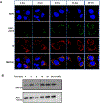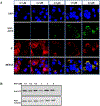Use of a Fluorescent Analogue of a HBV Core Protein-Directed Drug To Interrogate an Antiviral Mechanism
- PMID: 30375863
- PMCID: PMC6350927
- DOI: 10.1021/jacs.8b07988
Use of a Fluorescent Analogue of a HBV Core Protein-Directed Drug To Interrogate an Antiviral Mechanism
Abstract
Heteroaryldihydropyrimidines (HAPs) are antiviral small molecules that enhance assembly of HBV core protein (Cp), lead to assembly of empty and defective particles, and suppress viral replication. These core protein allosteric modulators (CpAMs) bind to the pocket at the interface between two Cp dimers and strengthen interdimer interactions. To investigate the CpAM mechanism, we wanted to examine the cellular distributions of Cp and the CpAM itself. For this reason, we developed a fluorescently labeled CpAM, HAP-ALEX. In vitro, HAP-ALEX modulated assembly of purified Cp and at saturating concentrations induced formation of large structures. HAP-ALEX bound capsids and not dimers, making it a capsid-specific molecular tag. HAP-ALEX labeled HBV in transfected cells, with no detectable background with a HAP-insensitive Cp mutant. HAP-ALEX caused redistribution of Cp in a dose-dependent manner consistent with its 0.7 μM EC50, leading to formation of large puncta and an exclusively cytoplasmic distribution. HAP-ALEX colocalized with the redistributed Cp, but large puncta accumulated long before they appeared saturated with the fluorescent CpAM. CpAMs affect HBV assembly and localization; with a fluorescent CpAM both drug and target can be identified.
Figures







Similar articles
-
Assembly Properties of Hepatitis B Virus Core Protein Mutants Correlate with Their Resistance to Assembly-Directed Antivirals.J Virol. 2018 Sep 26;92(20):e01082-18. doi: 10.1128/JVI.01082-18. Print 2018 Oct 15. J Virol. 2018. PMID: 30089690 Free PMC article.
-
The Heteroaryldihydropyrimidine Bay 38-7690 Induces Hepatitis B Virus Core Protein Aggregates Associated with Promyelocytic Leukemia Nuclear Bodies in Infected Cells.mSphere. 2018 Apr 18;3(2):e00131-18. doi: 10.1128/mSphereDirect.00131-18. Print 2018 Apr 25. mSphere. 2018. PMID: 29669885 Free PMC article.
-
A New Role for Capsid Assembly Modulators To Target Mature Hepatitis B Virus Capsids and Prevent Virus Infection.Antimicrob Agents Chemother. 2019 Dec 20;64(1):e01440-19. doi: 10.1128/AAC.01440-19. Print 2019 Dec 20. Antimicrob Agents Chemother. 2019. PMID: 31658963 Free PMC article.
-
Targeting the multifunctional HBV core protein as a potential cure for chronic hepatitis B.Antiviral Res. 2020 Oct;182:104917. doi: 10.1016/j.antiviral.2020.104917. Epub 2020 Aug 17. Antiviral Res. 2020. PMID: 32818519 Free PMC article. Review.
-
Antivirals interacting with hepatitis B virus core protein and core mutations may misdirect capsid assembly in a similar fashion.Biochem Pharmacol. 2003 Dec 15;66(12):2273-9. doi: 10.1016/j.bcp.2003.08.001. Biochem Pharmacol. 2003. PMID: 14637185 Review.
Cited by
-
Chemically Tagging Cargo for Specific Packaging inside and on the Surface of Virus-like Particles.ACS Nano. 2024 Aug 13;18(32):21024-21037. doi: 10.1021/acsnano.4c02056. Epub 2024 Aug 1. ACS Nano. 2024. PMID: 39087909 Free PMC article.
-
Virus self-assembly proceeds through contact-rich energy minima.Sci Adv. 2021 Nov 5;7(45):eabg0811. doi: 10.1126/sciadv.abg0811. Epub 2021 Nov 3. Sci Adv. 2021. PMID: 34730996 Free PMC article.
-
VHL-independent degradation of hepatitis B virus e antigen (HBeAg) by VHL-binding chimeric small molecules.RSC Med Chem. 2025 Mar 28. doi: 10.1039/d5md00118h. Online ahead of print. RSC Med Chem. 2025. PMID: 40276592 Free PMC article.
-
HBV Core Protein Is in Flux between Cytoplasmic, Nuclear, and Nucleolar Compartments.mBio. 2021 Feb 9;12(1):e03514-20. doi: 10.1128/mBio.03514-20. mBio. 2021. PMID: 33563815 Free PMC article.
-
Design, Synthesis, and Evaluation of a Set of Carboxylic Acid and Phosphate Prodrugs Derived from HBV Capsid Protein Allosteric Modulator NVR 3-778.Molecules. 2022 Sep 14;27(18):5987. doi: 10.3390/molecules27185987. Molecules. 2022. PMID: 36144715 Free PMC article.
References
-
- Lavanchy D Hepatitis B virus epidemiology, disease burden, treatment, and current and emerging prevention and control measures. J Viral Hepat 2004, 11, 97. - PubMed
-
- Ott JJ; Stevens GA; Groeger J; Wiersma ST Global epidemiology of hepatitis B virus infection: new estimates of age-specific HBsAg seroprevalence and endemicity. Vaccine 2012, 30, 2212. - PubMed
-
- Lozano R; Naghavi M; Foreman K; Lim S; Shibuya K; Aboyans V; Abraham J; Adair T; Aggarwal R; Ahn SY; et, a. Global and regional mortality from 235 causes of death for 20 age groups in 1990 and 2010: a systematic analysis for the Global Burden of Disease Study 2010. Lancet 2012, 380, 2095. - PMC - PubMed
-
- Buti M HBeAg-positive chronic hepatitis B: why do i treat my patients with Nucleos(t)ide analogs? Liver Int 2014, 34 Suppl 1, 108. - PubMed
-
- Jordheim LP; Durantel D; Zoulim F; Dumontet C Advances in the development of nucleoside and nucleotide analogues for cancer and viral diseases. Nat Rev Drug Discov 2013, 12, 447. - PubMed
Publication types
MeSH terms
Substances
Grants and funding
LinkOut - more resources
Full Text Sources
Miscellaneous

